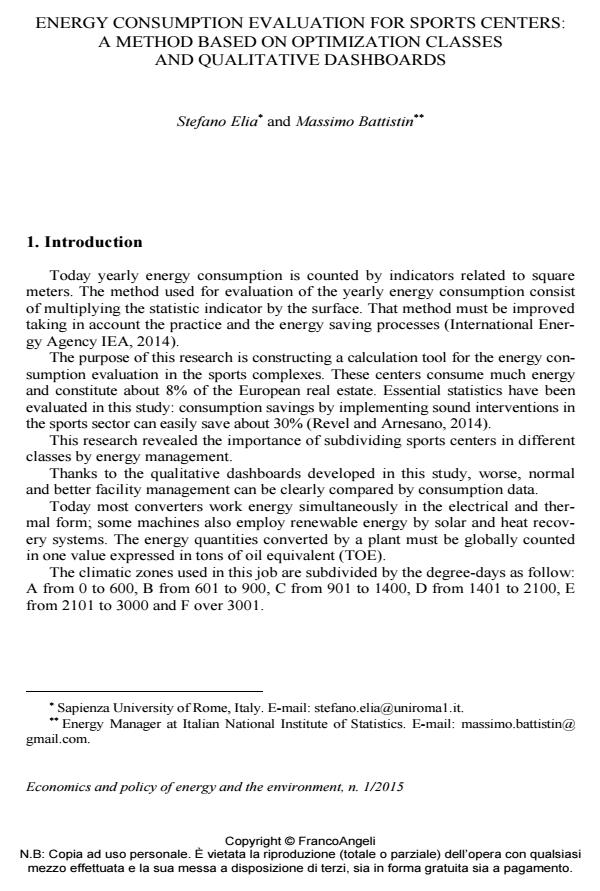Energy consumption evaluation for sports centers: a method based on optimization classes and qualitative dashboards
Titolo Rivista ECONOMICS AND POLICY OF ENERGY AND THE ENVIRONMENT
Autori/Curatori Stefano Elia, Massimo Battistin
Anno di pubblicazione 2016 Fascicolo 2015/1 Lingua Inglese
Numero pagine 12 P. 133-144 Dimensione file 301 KB
DOI 10.3280/EFE2015-001009
Il DOI è il codice a barre della proprietà intellettuale: per saperne di più
clicca qui
Qui sotto puoi vedere in anteprima la prima pagina di questo articolo.
Se questo articolo ti interessa, lo puoi acquistare (e scaricare in formato pdf) seguendo le facili indicazioni per acquistare il download credit. Acquista Download Credits per scaricare questo Articolo in formato PDF

FrancoAngeli è membro della Publishers International Linking Association, Inc (PILA)associazione indipendente e non profit per facilitare (attraverso i servizi tecnologici implementati da CrossRef.org) l’accesso degli studiosi ai contenuti digitali nelle pubblicazioni professionali e scientifiche
An evaluation method for sports center energy consumption is herein described. The proposed strategy can be used to estimate energy consumption at early design phase or serves as the baseline for comparison with the real consumption. About 200 sports centers - covering all of Italy - have been evaluated for energy consumption. Sports centers can be grouped into optimization classes based on a number of the saving interventions that have been implemented to save energy. The suitable saving processes are listed below. The consumption indicator of each sports center have been calculated and used in the evaluation model, representing the yearly energy consumption per surface unit of a particular sport structure, per climatic zone and per energy optimization class. The research also proved the non-linear relation between energy consumption and sports complex size. Therefore a scale factor has been calculated for each complex size and adopted. Finally, an innovative qualitative dashboard is proposed. The graphic output clearly links a consumption value to statistic data, showing a comparison with other sports centers data in the same boundary conditions.
Keywords:Dashboard, energy saving, sport center, optimization interventions, consumption indicators, mathematical model
Jel codes:L83, Q41, Q55
- Agarwal Y., Weng T. and Gupta R.K. (2009). The energy dashboard: improving the visibility of energy consumption at a campus-wide scale. Proceedings of the First ACM Workshop on Embedded Sensing Systems for Energy-Efficiency in Buildings – BuildSys ’09: 55-60. DOI: 10.1145/1810279.1810292
- Beusker E., Stoy C. and Pollalis S.N. (2012). Estimation model and benchmarks for heating energy consumption of schools and sport facilities in Germany. Building and Environment 49. DOI: 10.1016/j.buildenv.2011.08.006
- Boussabaine A.H., Kirkham R.J. and Grew R.J. (1999). Modelling total energy costs of sport centres. Facilities, 17(12/13): 452-461. DOI: 10.1108/02632779910293442
- Boussabaine A.H. (2001). A comparative approach for modelling the cost of energy in sport facilities. Facilities, 19(5/6): 194-203. DOI: 10.1108/02632770110387788
- BRECSU (1998). Energy Consumption Guide 51: Energy efficiency in sports and recreation buildings: a guide for owners and energy managers. Energy Efficiency Best Practice Programme.
- BRECSU (2001). Energy Consumption Guide 78: Energy use in sports and recreation buildings. Energy Efficiency Best Practice Programme. http://www.targ.co.uk/other/guide78.pdf.
- BS EN 16231:2012 (2012). Energy efficiency benchmarking methodology. DOI: 10.3403/30237966
- IEA (2014). “Energy Efficiency Indicators”: Fundamentals on Statistics, IEA, Paris. DOI: 10.1787/9789264215672-en
- International Energy Agency IEA (2014). “Energy Efficiency Indicators”: Essentials for Policy Making, IEA, Paris. DOI: 10.1787/9789264215665-en
- Maireta N. and Decellas F. (2009). Determinants of energy demand in the French service sector: A decomposition analysis. Energy Policy, 37(7), July: 2734-2744. DOI: 10.1016/j.enpol.2009.03.002
- Rasmussen N., Chen C.Y. and Bansal M. (2009). Business Dashboards: A Visual Catalog for Design and Deployment. Wiley, March 2009. DOI: 10.1002/9781119197904
- Revel G.M. and Arnesano M. (2014). Perception of the thermal environment in sports facilities through subjective approach. Building and Environment, 77, July: 12-19. DOI: 10.1016/j.buildenv.2014.03.017
- Revel G.M. and Arnesano M. (2014). Measuring overall thermal comfort to balance energy use in sports facilities. Measurement, 55, September: 382-393. DOI: 10.1016/j.measurement.2014.05.027
- Rodríguez González A.B., Vinagre Díaz J.J., Caamaño A.J. and Wilby M.R. (2011). Towards a universal energy efficiency index for buildings. Energy and Buildings, 43(4), April: 980-987. DOI: 10.1016/j.enbuild.2010.12.023
- Stoy C., Pollalis S. and Fiala D. (2009). Estimating buildings’ energy consumption and energy costs in early project phases. Facilities, 27(5/6): 187-201. DOI: 10.1108/02632770910944925
- Improvement of Energy Savings in Electric Railways Using Coasting Technique Donato Morea, Stefano Elia, Chiara Boccaletti, Pasquale Buonadonna, in Energies /2021 pp.8120
DOI: 10.3390/en14238120
Stefano Elia, Massimo Battistin, Energy consumption evaluation for sports centers: a method based on optimization classes and qualitative dashboards in "ECONOMICS AND POLICY OF ENERGY AND THE ENVIRONMENT" 1/2015, pp 133-144, DOI: 10.3280/EFE2015-001009